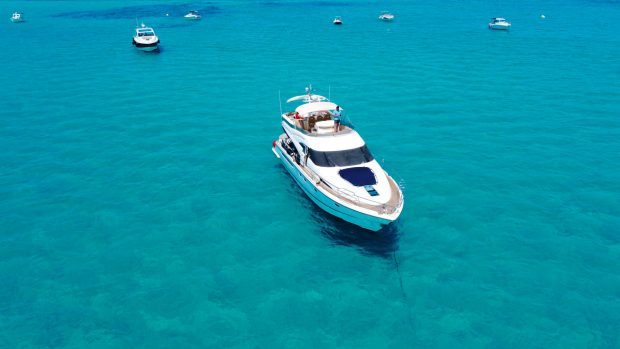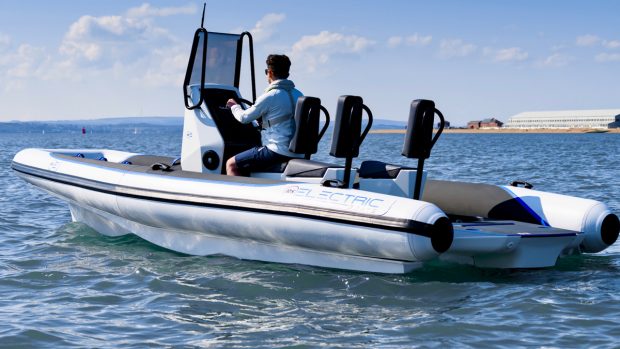We test a new dual-axis stabiliser, which promises to be the best of both worlds with retractable flapping fins
AntiRoll is a radical new stabilising solution that aims to combine the best elements of both gyroscopic and fin systems.
Most stabilisers fall into one of two camps: gyro-based systems such as Seakeeper and Mitsubishi ARG, which rely on a fast-spinning weight to keep the boat steady; or fin systems such as Sleipner, TRAC and CMC, which use a pair of tilting fins to counter roll.
Both systems are capable of working under way and at anchor, but fins tend to be most effective under way while gyros are at their best at anchor.
Flapping fins
The new AntiRoll system developed by Dynamic Marine Solutions (DMS) is unique in that its fins flap as well as tilt. It claims this allows them to counteract roll under way and at anchor without any of the usual compromises.
Conventional stabilising fins only tilt around a single axis so their ability to prevent roll at anchor is limited by the size and speed of the arc each fin can sweep before having to reset itself. Under way this isn’t a problem as the water flowing over the fins greatly increases the dynamic lift each fin can generate.
Gyroscopic stabilisers, on the other hand, offer the same level of roll-resistance both at rest and under way. This means they tend to be very effective at anchor but run out of steam under way in a big beam sea earlier than a fin system would. They also have the advantage of not having any external appendages to increase drag at planing speeds.
The new AntiRoll system can rotate through two axes. When under way, the fins tilt around a lateral axis just like conventional fin systems, providing lift on each side as required. However, at anchor, the AntiRoll fins also move up and down on a longitudinal axis, creating a flapping effect similar to a bird’s wings.
Because this flapping motion is directly opposed to the direction of roll, it is far more effective than the paddling effect of a conventional fin. The fins are also a very different shape to the normal stubby winglets, being twice as long as they are wide (known as a high-aspect ratio of 2:0). This means that they only need to tilt around 15º to produce the same degree of lift. Conventional shorter fins (with low-aspect ratios of 0:5 to 1:0) normally have to tilt 30º to have the same effect.
By limiting the angle of attack to 15º, drag is also reduced, response times are quicker and the power draw is lessened. This is because there is less pressure on the trailing edge of a narrow fin than a wider fin. The shaft is also located slightly aft of the leading edge, producing some counterbalance to the pressure exerted on the trailing edge. Conventional fin systems tend to mount their shafts on the leading edge in order to maximise the paddling effect at anchor. 

Fins with no drag
The big disadvantage of a long, high-aspect ratio fin is that when not in use they create more drag as well as posing a greater obstruction when berthing. So DMS has made the problem disappear at the press of a button – literally. When not in use the curved fins fold flat against the hull or into recesses. Another advantage of rotating the fins through a longitudinal axis is being able to adjust the positioning of the fins to suit each boats roll point.
With a conventional system the fins have to be set at a fixed angle, which is invariably a compromise between efficiency and the practical limitations of the hull design. Even after fitting, the DMS system can be adjusted to ensure it’s as close to the roll point as possible for maximum efficiency under way. This ability to rotate around two different axes is achieved using two sets of hydraulic actuators, one for each axis. The actuators for the lateral axis are located inside a cylindrical housing at the base of the fin.
The shaft for the fin passes through this cylindrical casing where it connects with the actuators. This whole cylindrical housing also rotates on its longitudinal axis, causing the fins to flap up and down. The fins are controlled by what DMS calls a Hybrid Power Train. The primary source of this Hybrid Power Train is a three-phase 400V AC generator. This is channelled to an AC/DC converter, which feeds two servo drive units (port and starboard) and a battery pack. The battery pack acts as a reservoir of DC current to provide a short-term boost.
The beauty of the system is that the pumps are fed by an electrically driven low-pressure supply (15-20 bar) from a central reservoir. Two small servo pumps then provide the final high-pressure boost of up to 250 bar. This removes the need for a much less efficient mechanically driven high-pressure hydraulic pump. At the moment the system is aimed at the 30m-plus market.
However, DMS claims the principle is equally effective on boats of all sizes, including planing and displacement craft. Whether it is physically and financially viable on smaller craft in the 15m to 30m bracket has yet to be seen but the speed with which the market for stabilisers on smaller boats is evolving suggests anything may be possible if the demand exists.
Contact www.dmsholland.com
Hydrodynamic lift causes powerboats to plane and aerodynamic lift causes aircraft to fly. The scientific principles are much the same, although wings produce lift on both sides whereas hulls only produce lift on the submerged side. In that respect, stabilising fins behave more like underwater wings.
Water flowing over the fins causes positive or negative lift, depending on whether the leading edge is higher or lower than the trailing edge. The degree of lift is dependent on the angle of attack and the speed of the water flow. The angle of attack is the angle between the surface of the object and the water flow. The further the fins tilt, the more lift they generate. The same holds true for the speed of the water flow.
The faster the boat moves through the water, the greater the lift. This lift isn’t just created by high pressure on the underside of the fins pushing the boat up, it’s also produced by low pressure on the upward surface pulling the fins in the same direction. It’s the combined effect of this that generates such a powerful lifting force from a relatively small surface area.
Fins also work at rest because Newton’s third law of motion states that to every action there is an equal and opposite reaction. So when a stabilising fin is pushed rapidly down against the water, an equal and opposite force is applied up by the water. Water in cold climates is denser than water in warm climates, so fins in the UK do not need to work as hard as they do in the warmer waters of the Mediterranean. First published in Motor Boat & Yachting, issue February 2014.
Subscribe to the print version of MBY
Subscribe to a digital version of MBY











